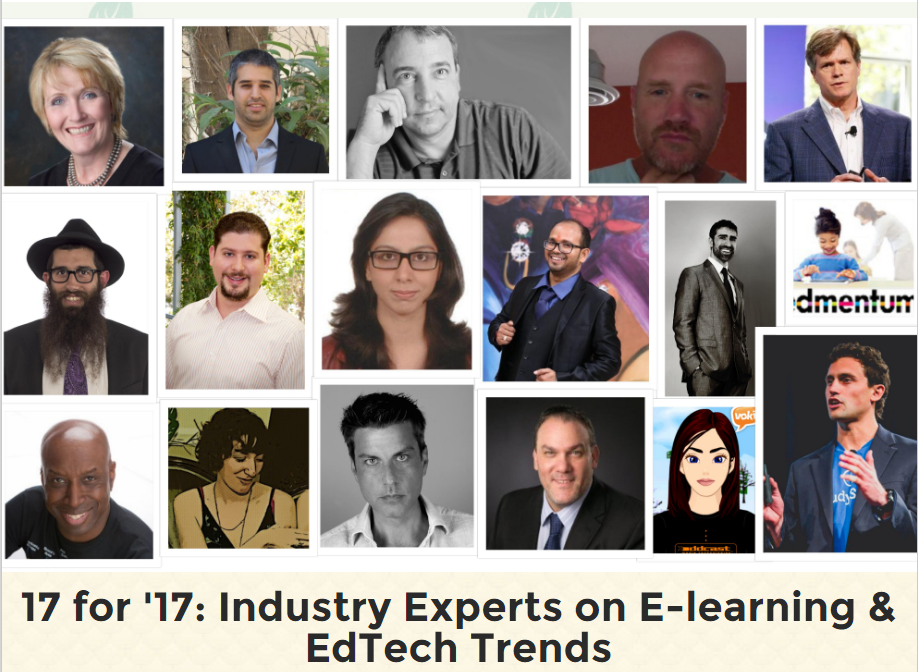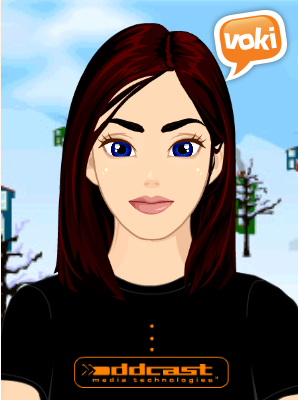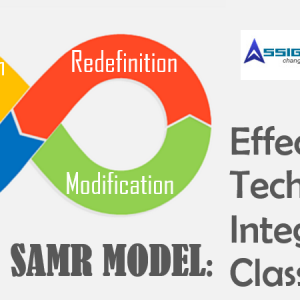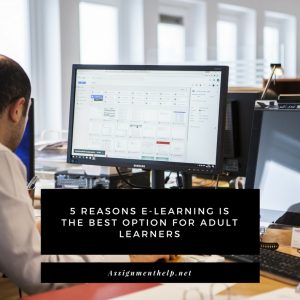17 for ’17: Industry Experts on E-learning & EdTech Trends for 2017

It’s almost time for the new year, new me posts. It’s time to predict what 2017 will be ushering in and also a time to look back at how the actuals aligned with the expectations for 2016. Every year, Assignmenthelp prepares an exhaustive guide of trends for e-learning and edtech tools that will hold strong ground in 2017 and disrupt the e-learning domain. This year we decided to ask 17 e-learning industry professionals on what they are placing their bets on to shape the e-learning and edtech trends of 2017 and over the next decade.
So here are the e-learning and edtech trends for 2017 handpicked by industry leaders.
Micro-learning
 Adrian Ridner, CEO and Co-founder of Study.com
Adrian Ridner, CEO and Co-founder of Study.com
How will microlearning disrupt the e-learning space in 2017?
Because of YouTube, Vimeo, Snapchat, etc., students now watch videos to get information and stay up-to-date. This has created a huge problem because there are a lot of unreliable sources on the Internet. Micro-video-learning addresses this issue by making lessons as engaging and interactive as popular sites and apps but also as reliable as subject textbooks and lectures. Instead of featuring a talking head, sites use more appealing, animated videos created by subject experts to bring tough topics to life. Study.com’s five-minute animated video lessons engage this generation of tech-savvy students that do everything on their smartphones—even study. Micro video lessons also provide a great opportunity to reach students that don’t learn from traditional classroom lectures or textbooks. In just a few minutes, students can master the same topics covered in class by reviewing in small, digestible chunks that make the concepts easier to understand and process. Micro video lessons that are both reliable and engaging will advance video learning well into 2017 and beyond.
What will be the key advance in micro-video-learning area in 2017 and over the next decade?
The key to advancing micro video learning will be to create original content that is both engaging and reliable. With the proliferation of fake news and biased websites, students will need to learn to evaluate information with a critical eye. In their quest for instant answers online, they will need to find reliable, unbiased sources they can trust for papers, one-off questions, and homework problems. As students continue to migrate to mobile platforms and the ability to do everything on the go becomes a common expectation, verified instant answers will be key in meeting their learning expectations and will ensure they avoid fake news and misleading information online. Instant answers together with short, video lessons provide students with access to subject-matter expertise in real-time and will become the expected standard for learning in 2017 and beyond.
iPads in classroom learning
 Michael Cohen; The Tech Rabbi LLC and Apple Distinguished Educator
Michael Cohen; The Tech Rabbi LLC and Apple Distinguished Educator
How will iPad disrupt the e-learning and education technology domain in 2017?
The iPad has come a long way since 2010. While many devices to date have reached a pinnacle in regards to hardware advancements, software is ever evolving and developing new ways for users to engage with their devices. One way the iPad will shine through the next year is going to be in how users collaborate, share, and interface with other users via their device. While Google has dominated live collaboration until recently, their software lacks a maturity that companies like Microsoft and Apple have spent decades refining. This makes their software function in a traditional setting but also be able function way outside the box. This allows Keynote for example to create content that might make it an unexpected choice when considering animation and motion graphics. This is because Keynote contains a powerful transition called Magic Move that can create high quality animated visuals with little effort on the part of the user. This coupled with the new collaborative features will make Keynote a new force to reckon with. Collaboration isn’t a new concept for Apple. Their devices have pioneered how users can share content on the fly with solutions such as Airdrop and Airplay, technology that other tech companies have yet to replicate at the same caliber. I see this taking a more significant role in how students create multimedia with apps such as iMovie allowing them to produce content as alternative assessments that not just hold them accountable for knowledge acquisition, but how they develop skills in planning, problem solving, and critical thinking as well. Still focusing on software, iOS 11 should see a significant development in Apple Education features and support. This area has been a major flaw resulting in many schools leaving iPad.
What will be the key advances in iPad-based classroom technology in 2017 and beyond?
In 2017, Apple will continue to develop the solutions they launched on iOS 10 showing schools that they consider device management as important as user experience. While I believe hardware development has in a sense peaked, there are still some exceptional ways in which it can impact the educational setting. With the iPhone 7’s introduction of a two lense camera, the iPad could see significant upgrades that can better support STEM when considering what camera zoom could do for traditional microscopic experiences. Finally, 2017 should see a leap in how we interface with our devices. While schools are spending thousands in developing keyboarding curriculum, tech giants like Apple are spending millions trying to make keyboards obsolete. I expect this coming year to see very real and very practical ways that we will be using other methods to create content. This doesn’t mean the keyboard is dead by any means, but it better get in line bending the optical drive, the mouse, and the recently deceased headphone jack. All in all, 2017 should see the iPad reinserting itself into the educational world as a device that does more than search the internet or create word docs, but as a critical tool for creation from imagination.
On-the-Job-tech education & STEM literacy
 Holly Benson, VP and Organizational Transformation Consulting Practice Leader, Infosys
Holly Benson, VP and Organizational Transformation Consulting Practice Leader, Infosys
How will e-learning and education technology disrupt On-the-job-tech-education and STEM literacy in 2017 and beyond?
The biggest priority for education next year must be keeping current with emerging technologies through on-the-job tech education, online learning, and by emphasizing computer literacy and coding skills:
For On-the-job tech education, Keeping current with emerging technologies in any field is a “tablestakes” requirement. Educating business leaders on technology is a growing imperative. Teaching decision-making skills and people-management skills will become increasingly important in most large corporations. In Online learning (both CBT/WBT and tactics like MOOCs and shared learning platforms) will continue to expand, supplemented by gamification techniques and perhaps a resurgence of classroom training for key soft skills. Online learning will also be important at all levels of public and private education. The partnership between business and education at the primary and secondary levels is still in its infancy, but will continue to expand. Both business leaders and educators are recognizing that new approaches will be required to prepare students for the job market of the future. Emphasis on computer literacy and coding skills is increasing and will continue to do so. Programs to attract females to STEM studies will grow and expand, as will programs to develop computer skills in underserved economies (including US poverty zones). Programs to develop complex cognitive skills, or approaches like design thinking, strategy, or even meditation and mindfulness, will also expand and become more common, to ensure that youth develop the cognitive and emotional skills to deal with the future work place. Major advances in primary and secondary education may actually come from developing nations, who do not have to undo or unlearn entrenched practices and can thus build in innovations at ground level.
Online Peer-based learning
 Sieva Kozinsky, CEO, StudySoup
Sieva Kozinsky, CEO, StudySoup
What will be the key advance in peer-to-peer e-learning space in 2017 and over the next decade?
Today, peer-to-peer online learning resources are extremely limited. Most resources available that are referred to as peer-to-peer learning are really connecting students to professionals/experts (teachers, tutors, or professors) instead of to another student. While there is definite value in connecting students with professionals and experts, we’ve also seen through countless studies that students learn best engaging in true peer discussions with other students. Peer-based learning encourages students to become active participants in the learning process. It’s also been shown to enhance crucial skills such as communication, critical thinking, and teamwork. Moreover, we know that 72% of a student’s learning time is done outside of the classroom and with peers. Over the next decade, we are going to see online learning adopt what’s already a natural learning process for students and provide them with a true way of connecting with peers through an online setting.
Artificial Intelligence
 Rakesh Kumar is co-founder of Augment Systems
Rakesh Kumar is co-founder of Augment Systems
How will Artificial Intelligence disrupt the e-learning arena in 2017 and over the next decade?
Advances made in Artificial Intelligence have become ubiquitous in our daily lives, be it in Mobile Assistants, smart gadgets, recommendation systems for movies, chat bots and much more. While development of AI in various fields has grown by leaps and bounds, there has not been any disruptive service/product when it comes to application of artificial intelligence in education and e-learning products and services. Various branches of AI including machine learning and deep learning will soon disrupt the e-learning domain and produce actionable learning analytics. These processes rest essentially on an intelligent system being able to parse the “big data” obtained from interaction with learners to identify meaningful patterns and transform it into structured knowledge and insights for future use. Plagiarism detection, especially involving advancements such as detecting plagiarism in paraphrased contents as well as semantically-enhanced plagiarism detection is another area being explored.
AI for eLearning application will include application of deep learning and natural language processing for developing intelligent tutoring systems as well as intelligent and automated content management systems. These content management systems in essence are learning content repositories that can instantly generate personalized e-books, assessments, textbook summaries, chapter outlines based on learning analytics data used to extract information about learner’s preferences and style of learning. Thus, the same content can be modeled into different forms and formats to support various learners. This will be able to drive personalized instruction to its truest core. Similarly, these repositories can auto-generate unlimited test-banks of questions in several formats as well as grade these automatically. There is also considerable work going on in the field of automatic essay graders which will utilize natural language processing and machine learning.
Deep learning can also be used for generating personalised recommendation systems for universities that will automatically suggest course modules that students should study next based on an intelligent assessment of their learning style, pace, strength, weaknesses as well as career or job based requirements.
Test-prep platforms
 Todd Rothman, co-founder of wyzPREP
Todd Rothman, co-founder of wyzPREP
How will e-learning disrupt the test-preparation space in 2017?
2016 has been a consequential year on many levels. When it comes to education and employment, we’ve witnessed some of the most impactful events of the decade. As the world around us is quickly changing, it becomes more and more difficult for students and young professionals to find the right formations for their chosen career paths. Employees in all industries are required to constantly update their skillsets while the emergence of new technologies has created completely new positions which require specific skills. As an education technology pioneer with over 18 years of experience in the sector, I have seen the impact of various tools and platforms on thousands of students. The future of education lies in technology – and it isn’t any different for test preparation. As an increasing number of students and professionals decide to apply for the GMAT and other highly competitive tests, the tools and platforms designed to help them succeed need to take advantage of the advancing technology to provide the best possible experience – and results. We are witnessing a real revolution in the way we teach and the way we learn and I am not expecting this trend to slow down in 2017. To the contrary, I believe this year will be full of technological advancements that will contribute to creating the online learning environment of the future.
What will be the key advance in online test-preparation space over the next decade?
In the upcoming months and certainly over the next decade, I expect to see highly interactive online learning platforms emerge. While there are already many options in the online test preparation sector, we need to be more innovative in our approach. Hard skills aren’t the only ones required for success anymore. Motivation, ambition and confidence are essential in our current job market and if tutors won’t teach them, who will? Artificial intelligence might still sound like something out of a science-fiction movie but we can already incorporate it in our everyday life, including when it comes to education. As an edtech entrepreneur, I believe we should invest in creating the perfect online classrooms, which would allow everyone to learn at their own pace while interacting with peers and tutors in real time. Students need to be challenged but also be free to study in an environment that matches their personality and learning style.
User-friendly EdTech
 Bryan Wetzel COO of Skubes inc.
Bryan Wetzel COO of Skubes inc.
What will be the key advance in user-friendly edtech space in 2017 and over the next decade?
Our company survey’s parents and teachers at the end of every year. There are three improvements that both teachers and parents are looking for. For teachers, it’s imperative that the technology gets easier to use and the technology fits into their daily routine. Sadly, a lot of technology gets bought by schools, each year, that doesn’t get used, which equates to tax money wasted. Talking with teachers, this happens for two reasons. First, the technology products that they are given are often difficult for them to figure out by themselves and most schools districts do not have the resources to train the teaching staff properly. Second, much of the technology requires teachers to change their routines to fit the technology. However, teachers are busy, and much of what they have to do is not negotiable. For K12 technology to move forward in 2017 and the next decade, it must continually become easier and more user-friendly. Our company is constantly trying to reduce the steps needed to use the tools that we offer for teachers and parents. K12 technology over the next decade will also need to have a visual workflow that allows users to use the tools without a lot of technical instruction. Borrowing the philosophy of Steve Jobs, who wanted technology products that didn’t require a manual.
Additionally, parents are looking for technology that works at home as well as in school. The future is for education technology to bridge the communication gap between what is going on in the classroom and what needs to be completed at home. Almost no schools districts send home textbooks anymore, especially, math textbooks. In the not too distant past, when a child said to their parents “I don’t understand my math homework,” the parents would tell the child to get out their textbook, flip to the chapter about the homework and they’d work thru homework together. In today’s world, that same scenario has a different ending. The child has no textbook, so the parents are Googling for answers, and they are not sure what they are searching for and aren’t sure if they found a resource that is aligned with the classroom lesson. This has lead to much frustration and anger with parents. Technology can correct this problem, and it is a big part of what we are doing and where a lot of technology needs to be heading. Our method of is to provide assignment tools for our content. But that is not the only solution, and it may not be the solution we stay with for the next decade. In the next ten years, K12 technology needs to provide educational tools and parent engagement simultaneously. Solving the parent engagement puzzle will require all of the above: ease of use, simplified workflow, and a bridge between school and home. The companies that make this work and have the content and tools to go with it will be the most successful.
Personalised learning
 Arvin Vohra, Founder, Vohra Method & author of The Equation for Excellence: How to Make Your Child Excel at Math
Arvin Vohra, Founder, Vohra Method & author of The Equation for Excellence: How to Make Your Child Excel at Math
How will e-learning disrupt the Personalised learning space in 2017?
Most educators and students agree that tutoring and other forms of highly personalized learning are more effective than one-size-fits-all methods. They also recognize that personalized methods are generally much more expensive, and impossible to do in group settings. Digital classrooms are changing that. They allow students in the same classroom to work on completely different areas, and allow teachers to monitor them closely and in real time. This allows students to work at their own ideal rates, rather than being either rushed ahead before they understand the topic, or forced to wait while others catch up. Individual pacing also prevents the creation of academic gaps. Digital classrooms also allow teachers to address different learning gaps for different students. For example, a teacher can give one student a worksheet about factoring and have another student watch a video about long division (a common occurrence in our classroom). Each student’s gaps can be corrected without interrupting or distracting other students. E-learning also allows for Rapid Teacher Collaboration (RTC). In a physical classroom, a new chemistry teacher cannot get quickly input from an experienced chemistry teacher down the hall. But digital classrooms allow new teachers to quickly get insights from experienced ones. A new math teacher may ask an experienced one the best way to explain a particular topic to a particular student. A new physics teacher might just need an explanation on how to do an advanced problem. In a well-designed digital classroom, each student is a second away from whoever has the most expertise. This takes personalization to a deeper level. A complex issue with any student can immediately be addressed by an experienced expert. These issues are routinely swept under the rug in physical classrooms. In online ones, the issues can be exposed and handled. Finally, because of their remote accessibility, online learning allows students to travel and learn.
What will be the key advance in Personalised e-learning over the next decade?
Over the next years, personalized online learning will become the standard for one reason: other methods cannot compete. Just as physical video stores could not compete with Netflix, physical classrooms will not be able to compete with online ones. What person would choose a one-size-fits-all physical classroom when they could have individualized instruction in a convenient digital classroom? What person would choose mediocre results from a physical classroom when they could have excellent results from a digital one? Who would settle for the local teacher, when they could access the best teachers in the world in a digital classroom? Who would choose the humdrum of studying from one place when the option to travel and learn at the same time was there? We have barely scratched the surface of the personalization possible with e-learning. As it continues to evolve, that individualization will make it the dominant form of education.
Mobile Learning
 Elad Shoushan, CEO, Ready4
Elad Shoushan, CEO, Ready4
How has mobile-based learning disrupted e-learning and education technology ?
In both the short term and long term, we’re going to see the rise of personalized learning, thanks to mobile learning advances. Mobile learning is growing rapidly, thanks to the newest generations of kids who are digital natives and more attached to their mobile devices than any group before them. Because education apps compete with other mobile apps such as Snapchat and Facebook for kids’ attention, mobile learning apps are being designed to be as good as other apps. We’re going to see more mobile learning solutions really figure out how to leverage the format for maximum benefit, making mobile learning 100% accessible–meaning, students can access the content at any time, from any place without constant internet or mobile data access. This allows students to fit learning into their schedules, rather than the other way around. Mobile solutions will also be able to adapt to students and become smart itself–an app can tell you what you need to study and how (thanks to adaptive learning algorithms, which customize lesson plans based on a student’s skill level), but also what time you need to study and where. Mobile learning also has the potential to bridge the gap between the virtual and digital worlds; we’ll see more mobile solutions knowing when it’s time to connect a student with a digital or physical educator–like the way Duolingo, for example, offers users chatbots to practice their language skills with–and thanks to the nature of mobile learning apps, that educator will get a comprehensive behavior and learning engagement report from the app to better equip themselves to provide personalized guidance.
What will be the key advance in the mobile learning space in 2017, and over the next decade?
Over the next decade, we’ll see more solutions using virtual or augmented reality to reach students in different ways. We’ll also see more content being designed specifically for mobile. When content started evolving from books-only to TV and video, it took about a decade to crack the code on how to most effectively present the material through a new medium; mobile learning faces a similar learning curve. Now, most people are still taking existing content from textbooks and e-learning systems and plugging it into a mobile interface; going forward, we’re going to see smarter ways of delivering content, and even more content that is designed specifically for mobile delivery. We’ll see more mobile solutions thinking about content in a mobile-first way, engaging students and learners with the right amounts of content pushed out at the right time, and using notifications to keep everyone involved.
Mobile Publishing Platforms
 Maxwell K. Riggsbee, Co-Founder and Chief Product Officer at Gadget Software
Maxwell K. Riggsbee, Co-Founder and Chief Product Officer at Gadget Software
How will Mobile-publishing platforms disrupt the e-learning space in 2017?
As we move into 2017, it will become crucial for educators and publishers to truly understand the end-user (students) as well as the content they consume, how they consume it and what medium they consume it on. The learning medium is mobile. The book (even in eBook form) has changed very little in over 500 years, while the ability to publish content has changed significantly. Today, information is more virtual than physical. We are networked to streams of data and learn in a nonlinear way. We’re connected to many sources and content exists in many forms. Media scholar, Marshall McLuhan said, “the medium is the message.” He asserted that medium (technology) is an, “extension of ourselves” the way a hammer extends our arm and hand or how wheels extend our legs and feet. Language media (text, images, audio and video) extend our thoughts. The medium shapes how we perceive things and interact with the world. It started in the mid-1400s when the printing press displaced manuscripts. Within the first 50 years the mechanical press overran 1000 years of manuscript production. As book production soared, prices fell, individuals and institutions acquired more books, while scholars complained about information overload. Printed books standardized language, sped communication and expanded ideas. By 1840, books had become a worldwide phenomenon and the primary medium for written content. Books became the way we learned. In the 1900s paperback editions made books more affordable, while pocket sized versions created a smaller lighter product. They remained unchallenged as the primary medium for written content until the World Wide Web project appeared in 1991. The web’s use of HTML offered the ability for anyone to create and publish hypermedia content (text, images, audio and video) via the internet. Through hyperlinking, authors could connect their ideas together. Throughout the years, the number of websites grew and search emerged as a critical resource to find, “things.” By 2006, there were 85 million websites servicing 1.1 billion users; The internet became the medium that changed how we learned. Yet, even as a wellspring of content appeared, the World Wide Web/Internet had one problem, neither fit into a pocket, purse, backpack or briefcase like a book. It was primarily a desktop and laptop experience confined to a location with an internet connection. In 2007, the introduction of the multi-touch smartphone sparked the transition from desktop browsing to mobile browsing. Smartphones are portable pocket-sized computing devices with operating systems, internet connections, high resolution touch screens, sensors and cameras. Most importantly, these devices support applications that leverage their robust functionality.
What will be the key advances in Mobile-publishing platforms in 2017 and over the next decade?
Today there are 2.6 billion smartphone users globally. By 2020, that number will jump to 6.4 billion with 80% of internet traffic dominated by smartphones. The multifaceted capabilities of smartphones, coupled with unprecedented global adoption, provide a perfect opportunity to rethink book content. Now we can extend hypermedia into spatial-media. Alongside traditional media, spatial-media leverages time, location and proximity to deliver relevant content. The smartphone is the new learning medium where virtualized content supplants fixed content to engage the learner in a non-linear, multimodal and contextual manner. Virtual Publications stream spatial-media, with context aware services, to provide a multidimensional experience. These provide learners information based on context. update in real-time, providing the learner the most current or expanded information. Virtual Publications are collaborative, enabling authors and learners to co-create outcomes. When and where we learn is of equal importance to what we learn. The learning medium is mobile and it’s delivering powerful messages to a new generation of learners.
Big Data
 Sarah Tippett, Editor of Homeschool Base, North Carolina
Sarah Tippett, Editor of Homeschool Base, North Carolina
What will be the key advance in Big Data for E-learning in 2017 and over the next decade ?
This year I saw more students using mobile devices for class/study/education than ever before. As mobile technology continues to become more widespread than desktop environments, educational programs, websites, and applications must all become mobile oriented. Just 10 years ago, teachers still scolded their students that they needed to learn math since they would never carry calculators around in their pockets. Our educational technology and classroom learning will begin to evolve around the gadgets we are never without. In 2017, I think we are going to see more impacts from Big Data than ever before. Big Data allows us to notice data trends in education and learning that were previously out of reach. Big Data can pick up on correlations and relationships that are literally invisible to the logical human brain, and don’t fit within our paths of understanding.
How will Big data disrupt the e-learning space in coming year?
The more data researchers collect about students in schools, tests, and behavior, the more patterns they are able to notice. Patterns in a student’s engagement level, mood, use of classroom resources, social habits, language, vocabulary, attention span, and academic performance are just a few types of data that help scientists begin to design the future of edtech. More edtech companies will be able to offer personalized learning. Through big data analytics, new technology will determine the best approach to teaching each individual student. AI algorithms (that trained on the Big Data) can adaptively offer each course based on the student’s weaknesses and strengths.
Online Tutoring
 Urvi Bhagi, e-learning enthusiast, AssignmentHelp
Urvi Bhagi, e-learning enthusiast, AssignmentHelp
Online Tutoring is one of the most widely adopted format of online learning. Online tutoring enables students (or learners) from anywhere in the world to connect with an online tutor instantly at the click of a button and receive academic assistance. The assistance could come in several forms ranging from help with tough problems of Mathematics, science, engineering, technology to even simpler requests such as proofreading student’s essay or guiding them in writing an annotated bibliography for their essay’s ideas. Online tutoring is now preferred by a growing number of students compared to traditional tutoring because of its advantages of being affordable, reliable, personalised as well as convenient.
Learners can easily sign-up too receive assistance from an online tutor of their choice from a simple click of a button. This can be done without bothering about the discomfort of spending hours in commute. We will also be seeing an early adoption of trends that will dominate in online tutoring space in 2017. Key trends we’re betting will include increased gamification for greater engagement and interaction within the elearning environment, as well as higher personalisation and well-tailored specific content customization. Traditionally online instructions in elearning courses have used ‘sit and watch’ strategy from participants without much active participation. Soon online tutoring will be able to take advantage of advances such as Augmented Reality and Virtual Reality features. These will enable tutors to easily visualise complex diagrams and models using interactive 3D & augmented reality models into lesson plans, e-books and other learning resources. Students, teachers and home schoolers will be able to easily access premium, ready-to-use 3D models and lesson plans for learning, creating and sharing their own content.
Adaptive Learning
 Team Edmentum
Team Edmentum
How will e-learning disrupt the adaptive learning space in 2017?
As students enter the classroom at the beginning of each semester, they bring their own strengths and weaknesses with them. Regardless of being in the same grade or class, every student is at a different academic level that continues to reveal itself as they manoeuvre through their learning paths. Educators use this variation in academic levels to assess a student’s capabilities and identify the specific support they may require. Teachers are now faced with the question of, “Is this instruction at the right pace for every student in the classroom”? Without applying the concepts of adaptive learning, the answer will sometimes be no. An adaptive learning path ensures that students receive a specifically tailored array of content and it begins with identifying where students are academically. We are experiencing a digital revolution in K-12 education and educators now have the ability to customize a student’s route to success. Rather than attempting to force students to adapt to a certain pace for content delivery, modern education technology adapts to the student. This paradigm is the backbone of personalized instruction and it grants each student greater control over how they will continue to learn and progress. This is a key concept that will be carried into 2017 and the years to follow.
What will be the key advance in Personalised e-learning over the next decade?
In this age of e-learning, software producers will continue to innovate their product lines to incorporate adaptive technology. Over the next decades, we can expect to see more mechanisms arise to support personalized education and establish an environment that can accommodate the myriad of ways students learn. These advancements will not only change the way students learn, but will also change the way educators teach. Rather than giving lectured lessons to the entire class, teachers will be free to help individual students while others work on their computers or tablets. Adaptive learning will continue to change the face of education. The notion of a traditional one-size-fits-all education plan diminishes the chances of personal skill growth for every learner. We are excited to be a part of creating a classroom experience that is remarkably different from a model that has dominated education for the past 100 years, providing teachers and students with a better means to reach personalized success.
E-learning for Early Childhood Education
 Marc Carver, Founder of FutureSoBrite
Marc Carver, Founder of FutureSoBrite
What will be the key advances in Early Childhood Education based e-learning sector in 2017 and beyond?
One of the biggest challenges facing effective early childhood education and knowledge development is attention span. Or rather the lack thereof. Attention span is defined as the amount of concentrated time one can spend on a task without becoming distracted. But sustained attention span is the one that really matters. Sustained attention span is what produces the most consistent learning results over time. A recent study by psychologists has determined that, over the last 10 years, our average sustained attention span has fallen from 12 minutes to just 5 minutes. So what does this mean? It means that when teaching our children something new, they are giving us approximately 5 minutes of focused, sustained attention to make it stick. Time is precious. We’ve always known this, even without science confirming it. Not surprisingly, many leading educators believe that the best method of actually teaching a subject is by delivering short, multiple, engaging bursts of information, repeatedly, over an extended period of time. In other words, capturing kids attention and then engaging them with rich content, in a compressed time period, leads to maximum learning absorption. It’s kind of a riff on the old “repetition gets results” theory updated for the digital age. Getting kids excited about learning is not easy. But fortunately, modern technology provides us with a lot of options other than the dry text books and long, boring lectures of the past (and in the case of a lot of schools, still the present). And I don’t just mean on line, monthly subscription “learning platforms” that really are just a bunch of games disguised as a teaching method. And although there is an abundance of supplemental educational materials available, both on line and in print, our research indicates that much of it is disjointed, contradictory, repetitive, and for lack of a better word, boring. The video lessons are designed to capture attention and deliver information simply and effectively. Segments average approximately 5 minutes in length, contain colorful graphics, voice narration, and comical characters that engage children and inspire multiple viewings, resulting in maximum knowledge retention. Digital. Mobile. Visual. Engaging. Effective. This is the kind of technology (and content) that will be trending in 2017 for early childhood learning and development.
E-learning for Non-traditional Learners
 Burck Smith, CEO & Founder of StraighterLine
Burck Smith, CEO & Founder of StraighterLine
How has e-learning disrupted education for non-traditional learners ?
In a recent blog post we celebrated the success of typical distance learners. I think their quotes in the post sum up how e-learning and education technology trends are changing the education landscape for non-traditional learners:
- Sheila Ann Jordan: Balances a full-time job to earn her degree as it’s “a stepping stone to even bigger goals.”
- Wayne Brown: realizes he can graduate at an accelerated rate, taking advantage of the flexibility of online transferable credit courses
- Kevin Linn: “Love technology and programming” and used online courses to complete prerequisites for a Bachelor of Science in Software Development
- Janna Rygol: Facing the realization of being laid off, Jenna was able to swiftly enroll in online education courses to complete prerequisites for a Master of Arts in Teaching Elementary Education program
Who is using online education technology?
- Financially independent adults — they have jobs, and engage in courses on their time, not a classic in-class schedule
- 52% have children — they need the flexibility of technology
- Many military members take advantage of online education because of commitments to their service duty
- International students take advantage of online education since they are living outside the United States
What will be the key advances in e-learning technology for non-traditional learners in the year 2017 and beyond?
With over 90% of colleges offering online courses at price points that are equal or higher than face to face courses, traditional higher education has been insulated from the economics of the Internet. The result has been the creation of a parallel, unsubsidized, and vibrant market of unaccredited providers who are able to exist because they offer courses and learning experiences that students prefer at prices and in formats that financial aid regulations won’t allow. As traditional institutions start to engage more directly with (or against) non-traditional providers, the impact of digital economics will creep into the traditional sector. There will be increasing price competition, particularly for online courses. It will be increasingly difficult for colleges to maintain their price points for online offerings and you’ll see shorter format offerings appear on the market. Companies like StraighterLine pioneer in offering online courses colleges courses that dramatically lowered the price and risk of starting a degree. Now, we’re starting to see widespread adoption. In the next decade or so, accredited colleges will be only one part of post-secondary education.
Gamification (Game-based learning)
 John Findlay, co-founder of Launchfire
John Findlay, co-founder of Launchfire
How will Gamification(and game-based learning) disrupt e-learning and education technology in 2017 and beyond?
2016 saw a rise in the popularity of gamification and game-based learning for education. But we still haven’t seen either approach reach its full potential. While the main advantage of a gamified approach is student’s reaction to it, the structure of a gamified program also lends itself to many other emerging trends in eLearning. In 2017, we expect to see the silos between these different eLearning trends break down, as instructors invest in more agile, engaging, and effective training programs. While gamification and game based learning were primarily discussed as a dichotomy in 2016, this year we believe the lines will begin to blur as instructors realize they can drive even better results by supporting their game based content within a gamified learning environment.
Mobile eLearning will continue to be a trend moving into 2017, as training becomes more flexible and on-demand for students. We’ll likely see the quality of mobile eLearning improve as instructors recognize they can’t just put old PDF content into a mobile learning platform. Gamification and game-based learning are particularly well suited for mobile platforms because of their bite-size nature so this is an area where we expect to see gamified training advance. The implementation of mLearning and on demand training allows for real-time collaboration, enabling social learning where students are able to share ideas and information. This type of learning community will be especially useful as organizations try to find ways to bridge the knowledge gap between generations. We expect organizations to begin to use gamification to drive participation in these eLearning communities, and encourage classmates to collaborate in order to earn extra points, badges, or rewards. Recent studies have shown that intense focus in humans only last 20 minutes. This means that we need new information delivered to us in shorter, more manageable chunks. We expect to see training content continue to be broken down into modules in order to increase retention — an area that gamification and game-based learning will undoubtable be used to drive repeat engagement. As training moves more and more online, we expect to see a shift towards on-demand training. This style of training would give end users control over their own training; letting them learn when, how, and what they want. Not only is this good for students (to give them control over their learning path) it’s also good for instructors who can set their employees up for future success in their class. On demand training also lets instructors fit training in and around their student’s schedule. All in all, 2017 will be an interesting year for eLearning as we continue to shift away old, static content into a more adaptable and interactive style of training.
Personal Chat-Bots
 Catherine Alvino, Digital Marketing Coordinator for Voki
Catherine Alvino, Digital Marketing Coordinator for Voki
What will be the key advance in personalised learning through teacher-bots in 2017 and over the next decade?
One of the key goals in education is to tap into the full learning potential of all students. We know that not all students learn alike, and personalised digital talking avatars like Voki caters to this diversity. These talking avatars will advance personalized learning in 2017 and in the next decade by leveling the playing field for all learning types, from nonverbal to advanced students. Having your avatar recite your words, either by recording your own voice or through text-to- speech, gives everyone a say in the classroom, even the shyest student. This will help in the proliferation of student voice and dissemination of ideas.
The ability to customize your own character will usher in a new sense of identity in the classroom. There are over 200 characters to choose from, and a virtual closet of clothing, costumes, and bling. Students can also adjust the shading of their avatars’ physical features. By choosing a character with their cultural background, for example, students can grow confidence at school finding alliance in their digital personas.
Engagement is another factor that drives learning. These interactive softwares boosts engagement by giving students control of their own learning. The process of creating such a digital-talking avatar is hands-on and self-directed, which validates a student’s capabilities and self-worth.
& That’s a wrap. We are excited to see what 2017 will bring in terms of new tools and technologies in e-learning and education technology space. What new trends are you betting on in 2017 ? Do let us know in comments.


![This is Why Teachers Need Tablets for Flipped Classrooms [Infographic] ipads in classroom](https://www.assignmenthelp.net/blog/wp-content/uploads/2017/03/tablets-in-classroom-300x300.png)